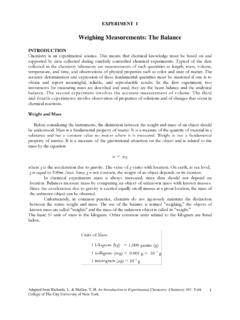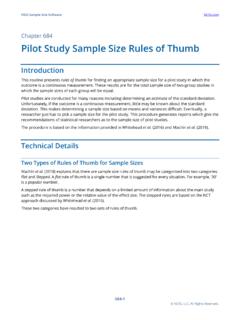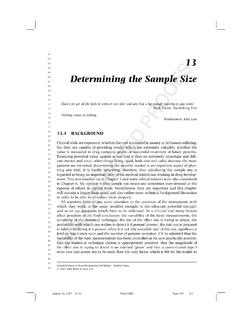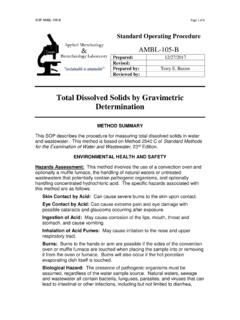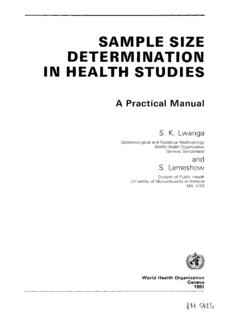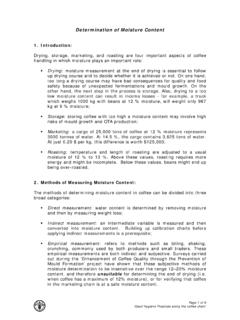Transcription of Volume Measurements and the Determination of Density
1 York College Chem 101 Laboratory Fall 2009. EXPERIMENT 2. Volume Measurements and the Determination of Density INTRODUCTION. In this experiment, equipment for the measurement of volumes is described and used. Volume Measurements are then combined with weight Measurements , described in the previous experiment, to determine the Density of a solid. Finally, a graphing procedure is combined with weight and Volume Measurements to determine the Density of a liquid. The basic SI unit of Volume is the m3. Smaller derived units are the cubic decimeter (dm3) and the cubic centimeter (cm3).
2 The cubic decimeter is commonly referred to as a liter (1 dm3 = I L = 10 3. m3) and the cubic centimeter as a milliliter (1 cm3 = I mL = 10 6 m3). In 1 liter there are 1000 mL. Volumetric Glassware The most commonly used items of volumetric glassware are the graduated cylinder, buret, pipet, and volumetric flask. As with the use of balances, the choice of volumetric glassware depends on the purpose of the measurement and the accuracy with which a Volume must be measured. Graduated Cylinders Graduated cylinders are available in many capacities from 5mL to 2000mL.
3 Each size has different calibration units and can be read with different degrees of accuracy. Small sizes can at best be read to + while larger sizes can only be read to 1 or 2 mL. Graduated cylinders are not used for very accurate quantitative Measurements . They are convenient for measuring and transferring liquids where exact volumes are not required. Burets Burets are commonly used where Volume Measurements to the nearest ml, are required. The burets used in this course are calibrated in increments and have 50mL capacities. The proper use of the buret involves the following steps.
4 (1) Clean the buret. (2) Rinse the buret with 5 6mL of distilled water. To thoroughly rinse a buret, it should be rolled on its side until all surfaces have been wet. The stopcock is then opened and the buret is drained. (3) Rinse the buret with 5 6mL of the solution to be used in the buret. (4) Fill the buret with solution. When filled, the buret should be drained until no air bubbles remain above or below the stopcock. If air bubbles are present, the dispensing of solution will not be quantitative. (5) Place the buret ett e vertically in a buret clamp supported by a ring stand.
5 (6) Record the initial buret Adapted from Richards, L. & McGee, T. H. An Introduction to Experimental Chemistry: Chemistry 101. York 1. College of The City University of New York. York College Chem 101 Laboratory Fall 2009. reading to the nearest To read the buret, first note that the zero calibration line is at the top and the 50mL. calibration is at the bottom of the buret. Volume readings are recorded before and after liquid is dispensed through the stopcock. The difference in these Measurements gives the Volume of liquid used.
6 The surface of the liquid in the buret is curved, not flat, due to the surface tension of the liquid. When recording a Volume , read the liquid level at the bottom of the curved surface or meniscus. A blackened card placed behind the buret usually helps to improve the visibility of the meniscus. Sample Buret Measurements Final Buret Reading mL. Initial Buret Reading mL. Volume Dispensed mL. Pipets Pipets Fill to this calibration s;; () a Measuring Pipets Mohr pipet 1''n!:1:1 '; 1t:, i er ttt1~ . <C 1'''t: c 1. Pipets are used to dispense a known Volume of solution quickly and accurately.
7 Two types of pipets exist: transfer pipets and measuring pipets. Each type is available in many capacities. Measuring pipets are calibrated in small increments of the total capacity of the pipet. Each size has different calibration units. They are read in the same manner as burets. Transfer pipets have only one calibration mark. They deliver a set Volume of liquid. When using either type of pipet, liquid is drawn up the pipet by using a rubber suction bulb NEVER BY MOUTH until the level is above the desired graduation mark. The liquid is then carefully lowered, by releasing the suction, until the bottom of the meniscus just coincides with the graduation mark.
8 Then the liquid is dispensed into the desired container by completely releasing the suction and allowing the pipet to drain. Many pipets are calibrated "to deliver" a specific Volume when filled and drained completely. A drop usually remains in the tip of the pipet, again due to surface tension, and should not be forced out. Pipets that hold lmL or more deliver the marked volumes with an error of .01 mL. Adapted from Richards, L. & McGee, T. H. An Introduction to Experimental Chemistry: Chemistry 101. York 2. College of The City University of New York.
9 York College Chem 101 Laboratory Fall 2009. Volumetric Flasks The volumetric flask is used for preparing solutions. It is available in various capacities and has a single graduation mark on the neck of the flask. When filled so that the bottom of the meniscus coincides with the graduation mark, the volumetric flask contains the specified Volume of liquid. Density Determination Density is a basic property of all pure substances. It is defined as mass (M) per unit Volume (V). D=M. V. If the mass and Volume of a substance can be measured, the Density can be calculated directly using this definition.
10 Alternatively, the Density of a material (and many other results) can be obtained from the proper graph of experimental data. Graphing allows the data to be presented visually and provides a means of averaging the data while obtaining the desired result. In the first part of this experiment, the Density of a metal is calculated directly. In the second part, the Density of a liquid is determined from an appropriate plot of the experimental data. In order to determine Density by graphing, the Density equation is rearranged to the more useful form M = D V.


